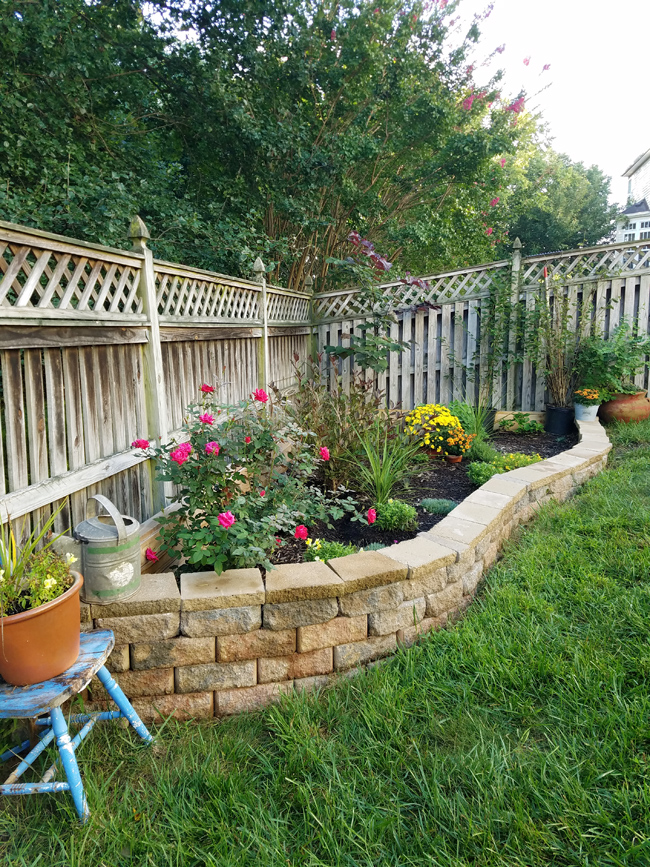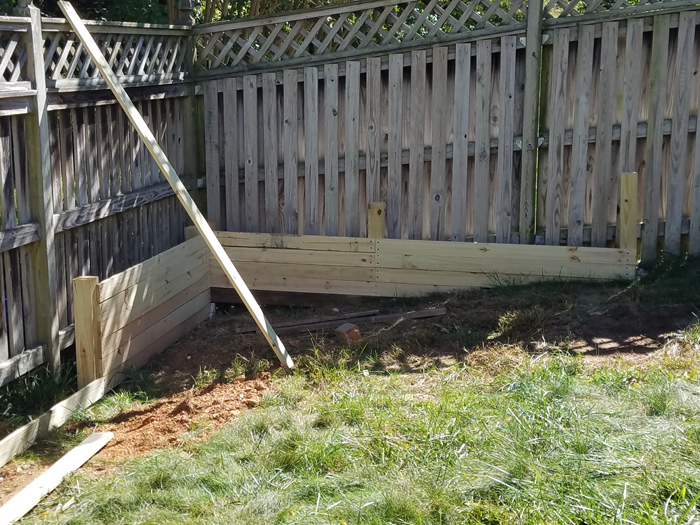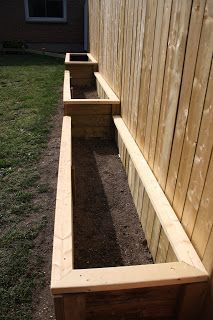
Building raised garden beds up against a wall is a simple and affordable method to take your garden vertical.
It’s innovative and affordable to create raised bed gardens next to a fence to maximize growing space. This technique makes the most of a yard’s layout and design as well as vertical fence space to increase garden space. When building a vegetable bed next to a fence, you must provide protection from soil, moisture, and termites.
There are certain drawbacks to it, though. You’ll discover the advantages and factors you should take into account in this post while installing raised garden beds next to a fence.
Table of Contents
Gardening Against Fence Line
A fence serves as a barrier, giving a garden definition and security. There are a few things to think about if you want to grow plants against your fence since you are running out of room.
Remove any weeds and soot from the area surrounding the fence to start. After that, place your plants along the fence taking into account how much sunlight they need.
Set your plant on the southern or western side of the fence if it need a lot of sunshine to grow. Place any plants that need shade on the eastern and northern sides of the barrier.
For your convenience, cultivate plants with comparable water requirements near to one another. Before growing any plants, think about the type of fence. For instance, a wooden fence needs periodic painting and costly care.
Therefore, if you need to repaint your fence, you need to provide enough space to get to it. Additionally, you can experiment with planting frameworks. Consider cultivating your plants in curvy or straight beds.
Plants To Grow Against Fence
You should plant little flowers and flowering shrubs as your choice of plant. You could also grow vines to cover fences. Any broken or rotting pieces of the fence will be covered up by the vines.
You can experiment with growing vegetables and herbs in raised garden beds in addition to vines. You’ll have organic vegetables this way to prepare wholesome meals at home.
Making your own elevated bed can occasionally be difficult. On Amazon, we discovered a sturdy and useful elevated bed that is decent and simple to install. Clicking here will take you there!
Benefits of Building a Garden Bed Against a Fence

There are advantages to creating a garden bed next to a fence. Here are some advantages:
Protects The Plants From Nature
Your garden has a border and is secure thanks to a fence. Raised garden beds near the fence line might offer your plants additional security.
Unfavorable weather elements including wind, intense sunlight, snow, and rain can be kept out by a fence. It serves as a windbreak and protects your plants from harm.
Additionally, it gives your plants shade and shields them from too much sunlight. Additionally, it shields your plants from rain and snow.
Saves Space
Every gardener aspires to have a diverse collection of plants in their space. To do this, you should aim to fit plants into a smaller space and conserve as much room as you can.
You can accomplish this by erecting garden beds up against the fence. With less space needed, you’ll have more room to grow additional plant species.
Looks Good
Building garden beds up to the fence line can enhance the attractiveness of your garden in addition to offering protection and saving space.
Your garden would look more attractive if you plant flowers in your garden beds. Anyone who sees the blossoms will be delighted by their vivid hue.
Additionally, adding garden beds along the fence will make your garden appear more well-kept and orderly. It will improve your lawn’s appearance overall even more.
Downside Of Building a Garden Bed Against a Fence
Even though creating garden beds next to a fence has numerous advantages, it also has disadvantages.
Soil Moisture Can Rot Wood
The soil can become damp when gardening next to a fence. A wooden fence might be harmed if the surrounding soil is consistently wet.
A fungal growth environment is favorable in damp wood. The fungi’s growth might cause the wooden fence to completely decay.
Soil Moisture Can Weaken Concrete Structures
Most people believe that because concrete buildings cannot rot, they are not impacted by soil moisture. This is not totally accurate because concrete constructions can get weaker due to soil moisture.
Concrete can become wet with extra soil moisture. In the water, some components of the concrete will disintegrate and leak out. The concrete structure will develop cracks as a result. These open gaps where air can easily collect make the concrete structure fragile.
Aside from the soil, trees and larger crops can also crack concrete because their roots reach deep into the ground in quest of nutrients.
Excess Moisture Can Cause the Fence to Sink
Building plant beds along the fence line may cause the soil nearby to become too wet. The wooden fence may decay due to wet soil.
The additional moisture in the earth makes it supple. Particularly in areas where the soil’s organic matter is high, the fence may sink into the ground due to the soft soil and decaying wood.
Check out this post to learn what makes soil sink.
Termites Within The Soil Can Attack Wooden Fences
Termites are underground organisms that are common around the world. By constructing a raised bed garden next to a fence, you can level the playing field and allow termites to attack the fence’s construction from a higher vantage point than they would otherwise be able to.
The soil affects how bad a termite infestation is. A garden may contain sand, potting soil, topsoil, clay, peat soil, etc. as well as other types of soil.
Subterranean termites need moisture to survive. They enjoy moist ground. For them to survive and develop, the moisture content offers the perfect atmosphere.
For more information on termites in raised bed gardens and how to prevent them, read this article.
This wooden raised bed garden is a good option that works well and is easy on your back. It is also simple to put together, strong, and reasonably priced. Clicking here will take you there!
7 Ways to Protect a Fence From Soil Moisture

Your fence may sustain serious damage from wet ground. It may cause the building to collapse, the wood to rot, or even cause the barrier to sink into the ground.
Therefore, it is essential to safeguard your fence against the negative effects of soil moisture. Here are some suggestions to prevent rotting on your fence:
1. Choose the Right Fence
Choosing a good material is the first step in protecting your fence. For your garden, look for a sturdy fence that won’t deteriorate. Redwood and cedar are two examples of premium materials that are resistant to decay.
Cedar fences are resilient and don’t deteriorate quickly. They are perfect for fences that are encircled by soggy soil. On the other hand, since woods like pine and Douglas fir can rot quickly, it is not advised to utilize them.
2. Install a Waterproof Barrier
There are numerous methods for preventing rotting from wet soil. One of them is making a barrier that is watertight.
Try utilizing a waterproof barrier if you are dissatisfied with only using high-quality fences. You can be confident that this will prevent soil moisture from harming your fence.
3. Plant a Few Inches Away From the Fence
– Cut Your Lumber. … Despite the many advantages, creating garden beds next to a fence also has disadvantages.
If you garden next to a fence, the ground may become soggy. A wooden fence might become damaged if the soil surrounding it is always damp.
4. Remove Rotten Areas
For fungi to flourish, damp wood is the perfect medium. Growing fungi may cause the wooden fence to completely decay.
Since concrete constructions cannot rot, most people believe they are not impacted by soil moisture. This is not totally accurate because soil moisture has been shown to degrade concrete constructions.
5. Stain Your Fence
The concrete may become wet from excess soil moisture. The water will dissolve and leach off some of the concrete’s constituent parts. As a result, the concrete building will have gaps. These empty gaps can quickly accumulate air, weakening the concrete structure.
In addition to the soil, trees and larger crops can also cause concrete structures to crack as their roots delve deep into the ground in search of nourishment.
There may be too much moisture in the soil nearby if garden beds are built along the fence line. The wooden fence could decay due to moist soil.
The ground is softened by the additional water present. In areas where the earth’s organic matter is plentiful, the combination of the decaying wood and the soft soil can cause the fence to sink into the ground.
6. Keep Your Fence Clean
Discover in this post what makes soil sink.
There are termites practically everywhere because they are underground animals. A raised bed garden next to a fence can level the playing field so that termites can attack the fence’s construction from a higher elevation rather than from the ground up.
The soil has an impact on how bad a termite infestation is. Sand, topsoil, potting soil, clay, peat soil, and other types of soil can all be found in gardens.
7. Examine Your Fence Regularly
Subterranean termites place a high value on moisture. They prefer moist ground. Their ability to survive and thrive is greatly aided by the moisture content.
To learn more about termites in raised bed gardens and how to prevent them, read our informative article.
This wooden raised bed garden is a good one that we got on Amazon. It’s simple to put together, strong, and reasonably priced. It works well and is easy on your back. Please click here to access it.
The Takeaway
Your fence may be seriously harmed by wet ground. It might result in the barrier sinking into the earth, the structure collapsing, or the wood decaying.
In order to avoid the negative impacts of soil moisture, it is essential to safeguard your fence. Here are some recommendations for preventing rot in your fence:
The first step in securing your fence is selecting a reliable material. For your garden, try locating a strong fence that won’t rot. Redwood and cedar are two materials with a high level of rot resistance.
Long-lasting and resistant to rot, cedar fences are a good choice. They work well for fences that are bordered by soggy soil. Alternatively, as pine and Douglas fir can rot quickly, it is not advised to utilize them.
FAQ
Can I build a garden next to my house?
Yes, it is a very nice idea to start a fruit or vegetable garden close to your home. It is even better if you grow it on a raised bed. It will be more convenient, you won’t have to worry about weeds, and you’ll have more control over the soil. There are some complications, though.
How far away from the house should a vegetable garden be?
As lime tends to seep out of foundations over time, changing the ph of the soil, try to keep at least 2 feet away from your home’s foundation. Also take into account the garden hose’s vicinity.
How close can a raised bed be to a house?
It is advised that raised bed gardens be built 1 to 2 feet away from a house so that the walls won’t be harmed by the garden’s roots.
